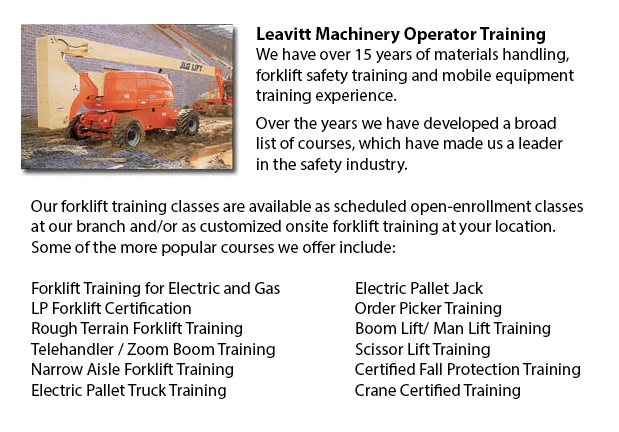
Kamloops Aerial Lift Safety Training - Each and every year, there are approximately 26 construction deaths due to the utilization of aerial lifts. Nearly all of the craftsmen killed are electrical workers, laborers, painters, ironworkers or carpenters. The majority of the deaths are caused by tip-overs, electrocutions and falls. The greatest danger is from boom-supported lifts, such as cherry pickers and bucket trucks. Most deaths are connected to this type of lift, with the rest involving scissor lifts. Other hazards include being thrown out of a bucket, being struck by falling objects, and being caught between the lift bucket or guardrail and an object, like for example a joist or steel beam.
To safely operate an aerial lift, carry out an inspection on the following things before making use of the device: emergency and operating controls, safety devices (e.g., guardrails and outriggers), personal fall protection gear, and tires and wheels. Inspect for possible leaks in the air, hydraulic fluid and fuel-system. Inspect the device for missing or loose parts.
The places where worker will use the aerial device must be inspected carefully for potential dangers, like for example holes, bumps, debris and drop-offs. Overhead powerlines have to be monitored and avoided. It is recommended that aerial lift devices be used on surfaces that are stable and level. Never work on steep slopes which go beyond slope limitations specified by the manufacturer. Even on a slope which is level, brakes, wheel chocks and outriggers must be set.
Employers are needed to provide maintenance mechanics and aerial lift operators with the right instruction manuals. Operators and mechanics must be trained by a licensed person experienced with the relevant type of aerial lift.
Aerial Lift Safety Guidelines:
o Close doors or lift platform chains before operating.
o Do not climb on or lean over guardrails. Stand on the floor of the bucket or platform.
o Utilize the provided manufacturer's load-capacity limitations.
o Make use of work-zone warnings, like for instance cones and signs, when working near traffic.
Electrocutions are preventable if safety procedures are followed. Stay as far away from power lines - at least 10 feet. Skilled electrical workers must insulate and/or de-energize power lines. People working have to utilize personal protective tools and equipment, like for example insulated bucket. Nonetheless, an insulated bucket does not protect from electrocution if, for example, the person working touches a different wire providing a path to the ground.
Falls are preventable if the individual working remains secure within guardrails or in the bucket by using a positioning device or a full-body harness. If there is an anchorage in the bucket, a positioning belt along with a short lanyard is acceptable.
By following the manufacturer's instructions, tip-overs could be avoided. Never drive the lift platform while it is elevated, unless otherwise specified by the manufacturer. Adhere to the device's horizontal and vertical reach limits, and never go beyond the load-capacity that is specified.
-
Kamloops Counterbalance Forklift Training
Kamloops Counterbalance Forklift Training - Counterbalance Forklift Training courses are always in high demand. The Counterbalance forklift is a forklift which is made with a weight which counters the balance, equally spreading the weight of the load... More -
Kamloops Manlift Certification
Kamloops Manlift Certification - The Manlifts and Elevated Platforms program offers training on the rules, regulations and proper application of safe operating measures and work practices included in daily activities for people who work making use of... More -
Kamloops Boom Lift Training
Kamloops Boom Lift Training - Elevated work platforms, likewise referred to as aerial platforms, allow workers to carry out tasks at heights that will otherwise be not reachable. There are various styles of lifts designed for different site applicati... More -
Operator Safety Certification | Re-Qualification Certification | In-House Instructor Certification in Kamloops
Forklifts are used in just about all industrial construction sites and in warehouse operations and in boat yards. The reach feature of a lift truck is a vital component used in several applications like for instance when a shelving system is being us... More -
Kamloops Manlift Safety Training
Kamloops Manlift Safety Training - It is essential for competent Manlift operators to be aware of the connected dangers that come with particular kinds of scissor lifts. They must be able to operate the scissor lift in a way that protects not only th... More -
Kamloops Crane Training Schools
Kamloops Crane Training Schools - We have designed several programs for Mobile Crane Operation at our Crane Training Schools. These programs are recommended for the experienced operator who requires certification or re-certification, and for inexperi... More -
Skid Steer Loader Certification in Kamloops
The engine powered skid-steer loader consists of a rigid and small frame, outfitted together with lift arms which could attach to a lot of industrial attachments and tools to perform several labor saving jobs. Typically, skid-steer loaders are four-w... More -
Kamloops Heavy Equipment License
Kamloops Heavy Equipment License - A heavy equipment license could be acquired by taking a certification and preparation course at a private training school or a vocational school. This license would qualify you to operate various types of heavy mach... More

Forklift Certification Kamloops
TOLL FREE: 1-888-254-6157
Kamloops, British Columbia
forkliftcertificationkamloops.com/
Email Us
About Us


